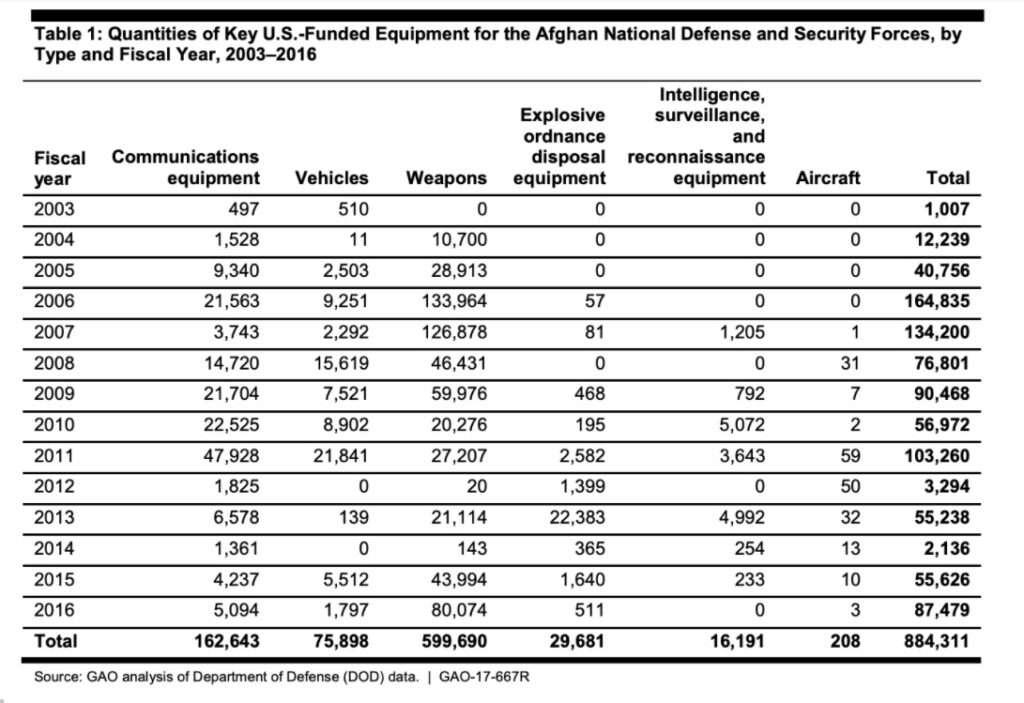The Taliban Got Their Hands on American Military Gear Because We Invaded Afghanistan, Not Because We Withdrew
After a nearly 20-year occupation, this was one inevitable outcome.

When a group of Taliban fighters stormed the hastily abandoned presidential palace in Kabul, Afghanistan, earlier this week, they carried a powerful symbol of the changing times: American-issued M16 and M4 rifles.
It's not just a propaganda coup. As the Taliban swept into full control of Afghanistan this week, they also claimed a cornucopia of military gear, equipment, and weapons that had been supplied to the Afghan government by the United States. There's no way to determine how much American military gear has ended up in the hands of Taliban fighters, but the "current intelligence assessment was that the Taliban are believed to control more than 2,000 armored vehicles, including U.S. Humvees, and up to 40 aircraft potentially including UH-60 Black Hawks, scout attack helicopters, and ScanEagle military drones," Reuters reported on Thursday, citing an unnamed U.S. official.
The aircraft and drones are probably useless without training and support staff. But the Humvees and small arms are exactly the sorts of things that a new regime could use to impose its will on the people of Afghanistan. After nearly 20 years of fighting, the Taliban that America is leaving behind is almost certainly better-supplied than it was when the U.S. military invaded in October 2001.
During the occupation, the U.S. transferred more than 600,000 guns (including those M16 and M4 rifles), 76,000 vehicles, and 162,000 pieces of communication equipment to the Afghan security forces, according to a 2017 Government Accountability Office (GAO) report (the report itself has seemingly been deleted from the GAO's website).
Since those figures are several years old, the actual totals are almost certainly higher.
"We don't have a complete picture, obviously, of where every article of defense materials has gone," Jake Sullivan, the White House's national security adviser, said Tuesday. "But certainly a fair amount of it has fallen into the hands of the Taliban, and obviously we don't have a sense that they are going to readily hand it over to us at the airport."
Be careful not to draw unrealistic conclusions about all this. After nearly 20 years of war in Afghanistan, there's no scenario in which the U.S. military wouldn't leave tons of weaponry and other gear behind. Despite what former President Donald Trump suggested in a statement this week, rolling up a long military occupation of a foreign country is not as simple as bringing out "all the equipment" and "then you bomb the bases into smithereens."
It's not that simple because a lot of American military gear was already in Taliban hands before the collapse of the American-backed Afghan military. A 2016 Pentagon audit found that poor record keeping was to blame for more than $1 billion in small arms that went missing during the occupations of Iraq and Afghanistan.
"Many of the Western weapons and equipment distributed like candy to battlefield partners in Iraq and Afghanistan since the start of the Global War on Terror have wound up in the hands of terrorists regardless of oversight efforts," military blog Task & Purpose concluded in 2017 after reviewing the Pentagon audit.
A lot more American military gear would have fallen into Taliban hands even if the Afghan military and government had managed to hold on for a few more weeks or months—as the Biden administration seemed to expect it would.
Indeed, after America's more orderly (first) withdrawal from Iraq in 2011, there were numerous reports of Islamic State of Iraq and Syria (ISIS) militias driving around in American vehicles and using U.S.-issued ammunition, including mortar shells and M16 rifles like the ones the Taliban are now showing off. A 2015 report from Amnesty International concluded that most of the weapons used by ISIS militias were drawn from "stockpiles captured from the U.S.-allied Iraqi military and Syrian rebels" armed by the U.S. and its allies.
War is messy. Nation building is complicated, bordering on the impossible. Cleaning up after a decades-long occupation is out of the question, so the only way to prevent this kind of thing from happening again is to not invade in the first place.

